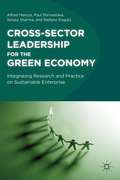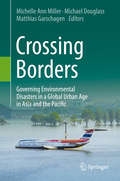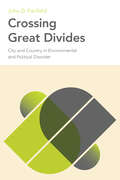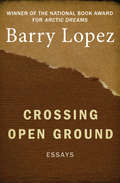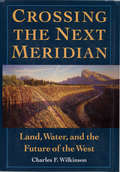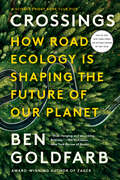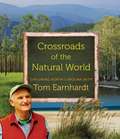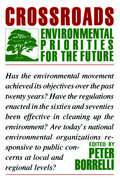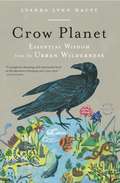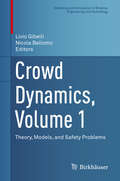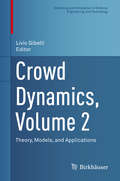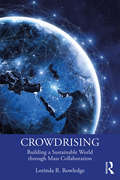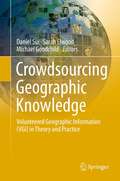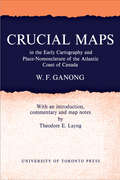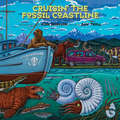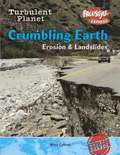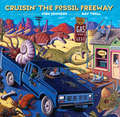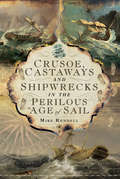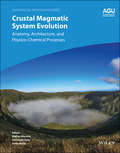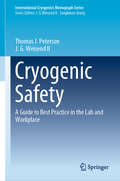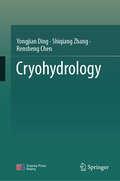- Table View
- List View
Cross-Sector Leadership for the Green Economy
by Paul Shrivastava Sanjay Sharma Alfred Marcus Stefano PogutzTechnology breakthroughs in sustainable renewable energy and energy conservation technologies require that there be a strong institutional ecosystem in place which supports innovation, but the nature of this foundation and how it works is not well-known. Becoming a leader necessitates new forms of cross-sector cooperation.
Crossing Borders: Governing Environmental Disasters in a Global Urban Age in Asia and the Pacific
by Michelle Ann Miller Matthias Garschagen Michael DouglassThis multidisciplinary book examines the diverse ways in which environmental disasters with compounding impacts are being governed as they traverse sovereign territories across rapidly urbanising societies in Asia and the Pacific. Combining theoretical advances with contextually rich studies, the book examines efforts to tackle the complexities of cross-border environmental governance. In an urban age in which disasters are not easily contained within neatly delineated jurisdictions, both in terms of their interconnected causalities and their cascading effects, governance structures and mechanisms are faced with major challenges related to cooperation, collaboration and information sharing. This book helps bridge the gap between theory and practice by offering fresh insights and contrasting explanations for variations in transboundary disaster governance regimes among urbanising populations in the Asia-Pacific.
Crossing Great Divides: City and Country in Environmental and Political Disorder (Urban Life, Landscape and Policy)
by John D. FairfieldRanging across two centuries of American history, Crossing Great Divides argues that the habit of construing city and country as opposites is at the root of our current environmental and political disorder. This oversimplifying dualism has distorted how we planned cities, our patterns of production and consumption, how we deal with waste, and how urban and rural populations perceive each other. Conventional urban environmental reform has made modern city life possible, but it has done little to limit the despoliation of distant places. Nevertheless, the successes of urban environmental reform remind us of what is possible. John Fairfield concludes with a case study of Phoenix, Arizona to demonstrate this dysfunctional relationship between city and country while developing a sympathetic critique of the Green New Deal. He suggests how we might bridge the “great divide” as we face the daunting challenges the twenty-first century is pressing upon us.
Crossing Open Ground
by Barry LopezNational Book Award–winning author Barry Lopez explores the challenges and joys of the human experience through the frame of the natural world in fourteen arresting and extraordinary essaysIn Crossing Open Ground, award-winning literary writer Barry Lopez offers prescient, beautiful, and thought-provoking reflections on how the natural world can define and illuminate our sense of self. Whether he&’s traversing the Arctic tundra or the deserts of the American Southwest, recalling the devastating beaching of forty-one sperm whales along the Oregon coast or reveling in the remarkable migrations of wild geese, Lopez shows readers the world&’s special places, its remarkable people, and stunning natural events. He thoughtfully explores humankind&’s place in this vast natural scheme, and opens our eyes to its breathtaking complexity. This ebook features an illustrated biography of Barry Lopez including rare images and never-before-seen documents from the author&’s personal collection.
Crossing Open Ground
by Barry LopezNational Book Award–winning author Barry Lopez explores the challenges and joys of the human experience through the frame of the natural world in fourteen arresting and extraordinary essaysIn Crossing Open Ground, award-winning literary writer Barry Lopez offers prescient, beautiful, and thought-provoking reflections on how the natural world can define and illuminate our sense of self. Whether he&’s traversing the Arctic tundra or the deserts of the American Southwest, recalling the devastating beaching of forty-one sperm whales along the Oregon coast or reveling in the remarkable migrations of wild geese, Lopez shows readers the world&’s special places, its remarkable people, and stunning natural events. He thoughtfully explores humankind&’s place in this vast natural scheme, and opens our eyes to its breathtaking complexity. This ebook features an illustrated biography of Barry Lopez including rare images and never-before-seen documents from the author&’s personal collection.
Crossing the Next Meridian: Land, Water, and the Future of the West
by Charles F. WilkinsonIn Crossing the Next Meridian, Charles F. Wilkinson, an expert on federal public lands, Native American issues, and the West's arcane water laws explains some of the core problems facing the American West now and in the years to come. He examines the outmoded ideas that pervade land use and resource allocation and argues that significant reform of Western law is needed to combat desertification and environmental decline, and to heal splintered communities. Interweaving legal history with examples of present-day consequences of the laws, both intended and unintended, Wilkinson traces the origins and development of the laws and regulations that govern mining, ranching, forestry, and water use. He relates stories of Westerners who face these issues on a day-to-day basis, and discusses what can and should be done to bring government policies in line with the reality of twentieth-century American life.
Crossings: How Road Ecology Is Shaping the Future of Our Planet
by Ben GoldfarbWinner of the Rachel Carson Award for Excellence in Environmental Journalism Finalist for the NYPL Helen Bernstein Book Award for Excellence in Journalism Finalist for the Reading the West Book Award in Nonfiction Finalist for the Colorado Book Award Named a Best Book of the Year by the New York Times, The New Yorker, Science News, Smithsonian Magazine, and Kirkus Reviews "A powerhouse of a book…comprehensive and engaging." —David Gessner, Washington Post An eye-opening account of the global ecological transformations wrought by roads, from the award-winning author of Eager. Some 40 million miles of roadways encircle the earth, yet we tend to regard them only as infrastructure for human convenience. While roads are so ubiquitous they’re practically invisible to us, wild animals experience them as entirely alien forces of death and disruption. In Crossings, environmental journalist Ben Goldfarb travels throughout the United States and around the world to investigate how roads have transformed our planet. A million animals are killed by cars each day in the U.S. alone, but as the new science of road ecology shows, the harms of highways extend far beyond roadkill. Creatures from antelope to salmon are losing their ability to migrate in search of food and mates; invasive plants hitch rides in tire treads; road salt contaminates lakes and rivers; and the very noise of traffic chases songbirds from vast swaths of habitat. Yet road ecologists are also seeking to blunt the destruction through innovative solutions. Goldfarb meets with conservationists building bridges for California’s mountain lions and tunnels for English toads, engineers deconstructing the labyrinth of logging roads that web national forests, animal rehabbers caring for Tasmania’s car-orphaned wallabies, and community organizers working to undo the havoc highways have wreaked upon American cities. Today, as our planet’s road network continues to grow exponentially, the science of road ecology has become increasingly vital. Written with passion and curiosity, Crossings is a sweeping, spirited, and timely investigation into how humans have altered the natural world—and how we can create a better future for all living beings.
Crossroads of the Natural World
by Tom EarnhardtIn this richly illustrated love letter to the wild places and natural wonders of North Carolina, Tom Earnhardt, writer and host of UNC-TV's Exploring North Carolina and lifelong conservationist, seamlessly ties deep geological time and forgotten species from our distant past to the unparalleled biodiversity of today. With varied topography and a climate that is simultaneously subtropical, temperate, and subarctic, he shows that North Carolina is a meeting place for living things more commonly found far to the north and south. Highlighting the ways in which the state is a unique ecological crossroads, Earnhardt's research, insightful writing, and stunning photography will both teach and inspire. Crossroads of the Natural World invites readers to engage a variety of topics, including the impacts of invasive species, the importance of forested buffers along our rivers, the role of naturalists, and the challenges facing the state in a time of climate change and sea-level rise. By sharing his own journey of more than sixty years, Earnhardt entices North Carolinians of every age to explore the natural diversity of our state.
Crossroads: Environmental Priorities For The Future
by James Gustave Speth Barry Commoner Robert Boyle Cynthia Wilson Richard S. Booth Amos EnoThe environmental movement today is at a critical crossroads. Crossroads: Environmental Priorities for the Future is an in-depth assessment of the movement's successes and failures, and also offers prescriptions for the future. It includes contributions from some of the country's top environmental leaders and activists, including Barry Commoner, Stewart Udall, William K. Reilly, Gus Speth, Jay Hair, Lois Gibbs, Michael Frome, Chuck Little, and William Futrell.
Crow Planet: Essential Wisdom from the Urban Wilderness
by Lyanda Lynn HauptThere are more crows now than ever. Their abundance is both an indicator of ecological imbalance and a generous opportunity to connect with the animal world. CROW PLANET reminds us that we do not need to head to faraway places to encounter "nature." Rather, even in the suburbs and cities where we live we are surrounded by wild life such as crows, and through observing them we can enhance our appreciation of the world's natural order. CROW PLANET richly weaves Haupt's own "crow stories" as well as scientific and scholarly research and the history and mythology of crows, culminating in a book that is sure to make readers see the world around them in a very different way.
Crowd Dynamics, Volume 1: Theory, Models, and Safety Problems (Modeling and Simulation in Science, Engineering and Technology)
by Nicola Bellomo Livio GibelliThis volume explores the complex problems that arise in the modeling and simulation of crowd dynamics in order to present the state-of-the-art of this emerging field and contribute to future research activities. Experts in various areas apply their unique perspectives to specific aspects of crowd dynamics, covering the topic from multiple angles. These include a demonstration of how virtual reality may solve dilemmas in collecting empirical data; a detailed study on pedestrian movement in smoke-filled environments; a presentation of one-dimensional conservation laws with point constraints on the flux; a collection of new ideas on the modeling of crowd dynamics at the microscopic scale; and others. Applied mathematicians interested in crowd dynamics, pedestrian movement, traffic flow modeling, urban planning, and other topics will find this volume a valuable resource. Additionally, researchers in social psychology, architecture, and engineering may find this information relevant to their work.
Crowd Dynamics, Volume 2: Theory, Models, and Applications (Modeling and Simulation in Science, Engineering and Technology)
by Livio GibelliThis contributed volume explores innovative research in the modeling, simulation, and control of crowd dynamics. Chapter authors approach the topic from the perspectives of mathematics, physics, engineering, and psychology, providing a comprehensive overview of the work carried out in this challenging interdisciplinary research field. After providing a critical analysis of the current state of the field and an overview of the current research perspectives, chapters focus on three main research areas: pedestrian interactions, crowd control, and multiscale modeling. Specific topics covered in this volume include: crowd dynamics through conservation lawsrecent developments in controlled crowd dynamicsmixed traffic modelinginsights and applications from crowd psychology Crowd Dynamics, Volume 2 is ideal for mathematicians, engineers, physicists, and other researchers working in the rapidly growing field of modeling and simulation of human crowds.
CrowdRising: Building a Sustainable World through Mass Collaboration
by Lorinda R. RowledgeOpen innovation enabled through crowdsourcing is one of the hottest topics in management strategy today. Particularly striking – and of vital importance to the world – are the pioneering efforts to apply crowdsourcing technology and open innovation to solve social, environmental, and economic sustainability challenges. CrowdRising sets out these challenges as context and then highlights the experiences of leaders and early adopters, identifies implementation guidelines, critical success factors and lessons learned, and finally projects where the field is going in the future. With a strong focus on the applications of crowdsourcing for innovation, engagement, and market intelligence, the book profiles the initiatives of companies, NGOs, and technology providers using crowdsourcing to develop these solutions to global problems. It addresses the key challenges impacting organizations: 1) identifying more sustainable ways to design, distribute, transport, recycle, and repurpose products; and 2) discovering and implementing the systems needed to transform global economic growth, drive human prosperity, and replenish the planet’s resources.
Crowded Planet: How humans came to rule the world (and how you can lessen our impact)
by Anna ClaybourneA powerful look at Earth's population crisis, written by award-winning children's author Anna ClaybourneThere are over 8 billion human beings living on Earth. That's a LOT of people! And the world's population is still growing, which leads to a big question ... are there too many of us? The human population has been rising since ancient times, but it has zoomed up especially fast over the last 100 years or so. While humans have been on Earth, we've made huge changes to the planet. We've built cities and roads and taken over wild areas, affecting the other living things we share our world with. We've polluted our skies, land and seas and are fast using up Earth's precious natural resources. How can we lessen our impact on Earth, before it's too late?ContentsA world full of people/The rise of humans/Population explosion/CASE STUDY: Crowded Tokyo/Taking over the world/Food and water/Population and health/Harming wildlife/CASE STUDY: Palm oil plantations/Country populations/Moving around/How many children?/CASE STUDY: Girls' education in Kenya/Population pyramids/Ageing populations/Falling populations/CASE STUDY: Plummeting population in Puerto Rico/Up or down?/What can you do?/Into the futureTitles in this series:Plastic PlanetHot PlanetPandemic PlanetRecycled PlanetSustainable PlanetExtinction PlanetPeaceful Planet?Unequal PlanetWatery Planet
Crowdfunding for Environmental Sustainability and the Circular Economy: Empowered Strategies for Sustainable Growth
by Marco Frey Filippo CorsiniThis book explores how crowdfunding can effectively promote environmental sustainability and circular economy practices in businesses, emphasizing its role in providing crucial financial resources. The importance of financial resources in businesses represents an essential enabler for implementing and scaling sustainable solutions. The book is composed of six chapters, which analyze some key aspects, such as how crowdfunding has been used to develop circular products, success factors for environmental crowdfunding campaigns, the issue of greenwashing in crowdfunding campaigns. By offering a comprehensive and critical analysis of the main issues at stake, this volume provides valuable insights for scholars and students of sustainable business and green finance. The present work also highlights how crowdfunding can help companies to integrate strategies to improve product environmental performance, engage in environmental marketing, and consider alternative business models. Overall, this book is essential to better understand how innovative funding solutions can overcome financial barriers and foster impactful environmental projects.
Crowdsourcing Geographic Knowledge: Volunteered Geographic Information (VGI) in Theory and Practice
by Sarah Elwood Michael Goodchild Daniel SuiThe phenomenon of volunteered geographic information is part of a profound transformation in how geographic data, information, and knowledge are produced and circulated. By situating volunteered geographic information (VGI) in the context of big-data deluge and the data-intensive inquiry, the 20 chapters in this book explore both the theories and applications of crowdsourcing for geographic knowledge production with three sections focusing on 1). VGI, Public Participation, and Citizen Science; 2). Geographic Knowledge Production and Place Inference; and 3). Emerging Applications and New Challenges. This book argues that future progress in VGI research depends in large part on building strong linkages with diverse geographic scholarship. Contributors of this volume situate VGI research in geography's core concerns with space and place, and offer several ways of addressing persistent challenges of quality assurance in VGI. This book positions VGI as part of a shift toward hybrid epistemologies, and potentially a fourth paradigm of data-intensive inquiry across the sciences. It also considers the implications of VGI and the exaflood for further time-space compression and new forms, degrees of digital inequality, the renewed importance of geography, and the role of crowdsourcing for geographic knowledge production.
Crucial Maps in the Early Cartography and Place-Nomenclature of the Atlantic Coast of Canada
by William F. Ganong Theodore F. LayngThe Transactions of the Royal Society of Canada for the years from 1929 to 1937 included a series in nine parts of important papers on "Crucial Maps" which have been a frequent source of reference ever since for students of the history of discovery and of early cartography. Their author, William Francis Ganong, had a life-long interest in the natural and human history of his native province, New Brunswick. Although he was primarily a botanist, with four full-length books and an amazing number of articles to his credit, it was through his series of monographs in the Transactions of the Royal Society of Canada that the breadth of his interests became known. For over fifty years he contributed almost annually to the Transactions the results of his systematic investigations into New Brunswick's physiography, aborigines, early explorations, wars and settlements. Crucial Maps, which concluded in 1937, was the last series of articles. Ganong was the first investigator to employ a critical classification of maps based upon groupings by period and type, although the cartography of Canada's east coast had earlier been introduced by Baron Alexander von Humboldt. Ganong's contributions to cartography are enormous: for example, his reconstruction of Cabot's voyages, while all may not agree with it, is a masterpiece of inductive analysis which will remain a model in historical research; his chapters on Gomez, Verrazzano and Fagundes are still the chief secondary sources on these discoverers. There have been notable additions to the bibliography of discovery and maps since Ganong wrote; recently published works as well as the complete file of Ganong's correspondence with his fellow cartographer, G.R.F. Prowse, were consulted by Theodore E. Layng, Map Division, Public Archives of Canada, in preparing the commentaries which accompany this edition of Crucial Maps. These commentaries, with Mr. Layng's introduction, also provide an interesting sketch of Dr. Ganong and his work. Another important feature of this edition is the index prepared by William Morley of the John Carter Brown Library. In much of his work Ganong was a pioneer, and, while subsequent studies have reached different conclusions on some points, many of his results have seldom been challenged. Students of the present and future will still use and quote from Crucial Maps. Royal Society of Canada Special Publications No. 7
Cruisin' the Fossil Coastline: The Travels of an Artist and a Scientist along the Shores of the Prehistoric Pacific
by Ray Troll Kirk R. JohnsonIn this long-awaited sequel Kirk Johnson and Ray Troll are back on a road trip—driving, flying, and boating their way from Baja, California to northern Alaska in search of the fossil secrets of North America's Pacific coast. They hunt for fossils, visit museums, meet scientists and paleonerds, and sleuth out untold stories of extinct worlds. As one of the oldest coasts on earth, the west coast is a rich ground for fossil discovery. Its wonders include extinct marine mammals, pygmy mammoths, oyster bears, immense ammonites, shark-bitten camels, polar dinosaurs, Alaskan palms, California walruses, and a lava-baked rhinoceros. Join in for a fossil journey through deep time and discover how the west coast became the place it is today.
Crumbling Earth: Erosion and Landslides (Turbulent Planet)
by Mary ColsonWithout notice, Earth's surface can change drastically and dramatically. As this exciting drama fully plays out on each page of this series, readers confront the physical and social impact of events and their aftermath. Geography and social science are made frighteningly real and relevant, as is the need for conservation and preventive measures. Each title includes a survival guide that recaps highlights from the book and provides a checklist of survival tips and precautions.
Crusin' the Fossil Freeway: An Epoch Tale of a Scientist and an Artist on the Ultimate 5,000-Mile Paleo Road Trip
by Kirk JohnsonThe travels of a paleontologist and an artist as they drive across the American West in search of fossils. Throughout their journey, they encounter "paleonerds" like themselves, people dedicated to finding everything from suburban T. rexes to ancient fossilized forests.
Crusoe, Castaways and Shipwrecks in the Perilous Age of Sail
by Mike Rendell&“Fascinating&” stories of real-life people and events that inspired the author of the classic adventure novel Robinson Crusoe (Historical Novel Society). This book looks at some of the stories that inspired Daniel Defoe, author of Robinson Crusoe—stories of bravery, determination, and good fortune, as well as human negligence, sheer stupidity, and bad luck. In addition to an overview of Defoe&’s life and his monumentally successful novel, it also considers some of the reasons why people found themselves cast away—as a result of being wrecked, abandoned as a punishment, or marooned by pirates, or even out of deliberate choice. Major hurricanes in the eighteenth century causing huge damage to shipping and loss of life are also covered, along with catastrophes when ships were lost, and astonishing tales of survival in the face of adversity—down in the Falklands, in the Caribbean, and off the coast of Australia. It looks at how being cast away brings out the best in some—and in others the very worst. And it examines perhaps the most astonishing story of them all—sixty slaves abandoned on a desolate treeless island in the Indian Ocean and left there for fifteen years, some of whom survived against all odds.
Crustal Evolution and Metallogeny in India
by Sanjib Chandra Sarkar Anupendu GuptaCrustal evolution means the resultant changes that the Earth's crust has gone through in its geologic past affected by changes in the mantle-crust system, the atmosphere, the hydrosphere and the biosphere. Metallogeny is the genesis of metallic mineral deposits. Both the terms are used in the book in their conventional sense, but keeping in mind an Indian context. This book is the first of its kind to document in detail the nature, origin and evolution of mineral deposits in India and is contextualized in local, regional and global geology. The book is unique in that it combines both metallogeny and crustal evolution that were hitherto treated as stand-alone topics. The exhaustive chapters in the book carry detailed case studies of the distribution and occurrence of ores. The book would be useful to students of advanced geology, researchers, teachers, planners and global metallogeneticists around the world.
Crustal Magmatic System Evolution: Anatomy, Architecture, and Physico-Chemical Processes (Geophysical Monograph Series)
by Christoph Beier Matteo Masotta Silvio MolloA comprehensive picture of the architecture of crustal magmatic systems The composition of igneous rocks – their minerals, melts, and fluids – reveals the physical and chemical conditions under which magmas form, evolve, interact, and move from the Earth’s mantle through the crust. These magma dynamics affect processes on the surface including crustal growth and eruptive behaviour of volcanoes. Crustal Magmatic System Evolution: Anatomy, Architecture, and Physico-Chemical Processes uses analytical, experimental, and numerical approaches to explore the diversity of crustal processes from magma differentiation and assimilation to eruption at the surface. Volume highlights include: Physical and chemical parameterization of crustal magmatic systems Experimental, theoretical and modelling approaches targeting crustal magmatic processes Timescales of crustal magmatic processes, including storage, recharge, and ascent through volcanic conduits The American Geophysical Union promotes discovery in Earth and space science for the benefit of humanity. Its publications disseminate scientific knowledge and provide resources for researchers, students, and professionals.
Cryogenic Safety: A Guide to Best Practice in the Lab and Workplace (International Cryogenics Monograph Series)
by Thomas J. Peterson J. G. Weisend IIThis book describes the current state of the art in cryogenic safety best practice, helping the reader to work with cryogenic systems and materials safely. It brings together information from previous texts, industrial and laboratory safety polices, and recent research papers. Case studies, example problems, and an extensive list of references are included to add to the utility of the text. It describes the unique safety hazards posed by cryogenics in all its guises, including issues associated with the extreme cold of cryogenics, the flammability of some cryogenic fluids, the displacement of oxygen by inert gases boiling off from cryogenic fluids, and the high pressures that can be formed during the volume expansion that occurs when a cryogenic fluid becomes a room temperature gas. A further chapter considers the challenges arising from the behavior of materials at cryogenic temperatures. Many materials are inappropriate for use in cryogenics and can fail, resulting in hazardous conditions. Despite these hazards, work at cryogenic temperatures can be performed safely. The book also discusses broader safety issues such as hazard analysis, establishment of a safe work culture and lessons learned from cryogenic safety in accelerator labs. This book is designed to be useful to everyone affected by cryogenic hazards regardless of their expertise in cryogenics.
Cryohydrology
by Yongjian Ding Shiqiang Zhang Rensheng ChenThis book is devoted to the study of cryohydrology in hydrological research in cold regions through theoretical aspects, field observations, remote sensing and GIS, hydrological model, and impacts on regional and global scales. Understanding cryohydrology is a prerequisite to the hydrological processes in cold regions. The book aims to serve as a guide for understanding and developing cryohydrology by observation and modeling. It is motivated by recent rapid advances in cryospheric science including the discipline trees, in addition to the impact of cryospheric changes on different scales. Chapters are carefully developed to cover (1)development of cryohydrology, (2) research methods, (3) ablation, runoff generation and routing, (4) meltwater runoff, (5) hydrochemistry, (6) river sediment, (7) roles in watershed, and (8) impact on global water cycle. It addresses the above issues with a holistic and systematic approach that utilizes observation to simulation. The book is written for scholars working in hydrological research fields as well as stakeholders engaging in environmental sustainability in cold regions.
